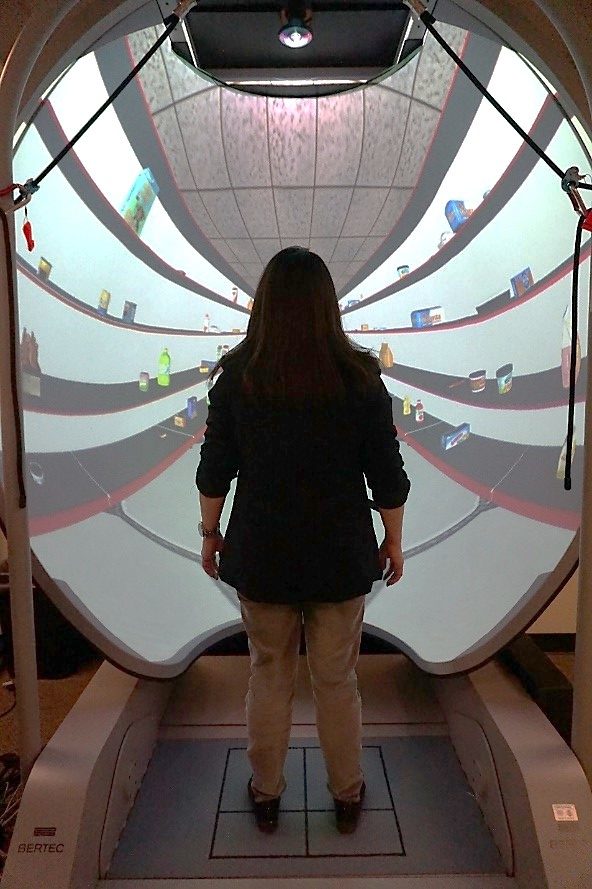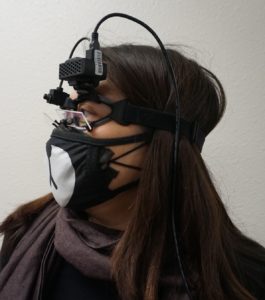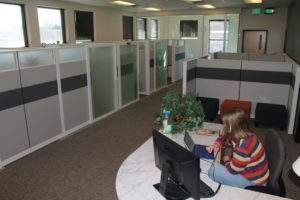Story by Giulia Deem
Occupational therapy has a rich past, but the profession is anything but history; it has an ever-expanding future. The Department of Occupational Therapy at Colorado State University continues to make strides in moving the program and field forward in many ways.
Room for research
 One way the program is progressing is through renovated research space for the department. Research is essential for the continued effectiveness and relevance of occupational therapy, and faculty members in the Department of Occupational Therapy at CSU are leading novel research in remodeled spaces of Aggie Labs at the Foothills Campus.
One way the program is progressing is through renovated research space for the department. Research is essential for the continued effectiveness and relevance of occupational therapy, and faculty members in the Department of Occupational Therapy at CSU are leading novel research in remodeled spaces of Aggie Labs at the Foothills Campus.
Yawen Yu, assistant professor, studies how sensory signals are used to maintain balance and upright posture. These are fundamental for participation in daily activities and quality of life.
 Among Yu’s repertoire of research equipment is an immersive virtual environment dome. Participants standing inside the dome are measured for their postural response to sensory perturbations using a force plate and motion sensors.
Among Yu’s repertoire of research equipment is an immersive virtual environment dome. Participants standing inside the dome are measured for their postural response to sensory perturbations using a force plate and motion sensors.
Yu shares, “An individual that over-relies on vision and underappreciates the changing sensory environment would have difficulties in keeping their balance during upright standing.” Yu uses physiological measurement to examine the integration between visual and inner ear balance systems. A pair of specialized goggles measures the reflex that stabilizes eye gaze during head movement.
Arlene Schmid, professor, is experienced in how occupational therapists can use yoga with their clients and is using the research space for studies relating to this emerging area of practice. Although Schmid has conducted her research at the Foothill Campus for the past few years, she shares that COVID-19 has altered these studies to remote and hopes that they will return to in person soon.
Typically, Schmid and her team modify yoga postures to enable everyone to be successful in the intervention through use of chairs, a variety of yoga gear, and mat tables. Schmid says, “Right now, we are finishing up a study of yoga and education for people with chronic pain and we are excited for our future studies to continue to use this exceptional research space.”
 Shelly Lane, professor, is conducting research regarding pediatric occupational therapy in her lab, Sensory Integration, Play, and Occupational Therapy Research Center. “We anticipate working with families and children who are experiencing, or are at risk for, challenges to sensory integration and play,” Lane shares. The center has the appearance of an indoor playground, with a sensory integration/playroom, a caregiver conference/coaching room, and an observation room that is equipped with one-way windows into both spaces.
Shelly Lane, professor, is conducting research regarding pediatric occupational therapy in her lab, Sensory Integration, Play, and Occupational Therapy Research Center. “We anticipate working with families and children who are experiencing, or are at risk for, challenges to sensory integration and play,” Lane shares. The center has the appearance of an indoor playground, with a sensory integration/playroom, a caregiver conference/coaching room, and an observation room that is equipped with one-way windows into both spaces.
Lane says, “Research expertise in sensory integration, play, and physiological measurement of arousal and regulation will support a variety of projects.”
Acquiring new spaces
 In preparation of a new entry-level doctoral program which is anticipated to begin in May 2022, additional space was needed to accommodate the needs of the department. As space can be hard to come by at CSU, the department is thankful to have room to grow by acquiring space in Alder Hall. This new space is being used by the Center for Community Partnerships, a center whose mission is supporting the inherent dignity, potential, and full participation of all people.
In preparation of a new entry-level doctoral program which is anticipated to begin in May 2022, additional space was needed to accommodate the needs of the department. As space can be hard to come by at CSU, the department is thankful to have room to grow by acquiring space in Alder Hall. This new space is being used by the Center for Community Partnerships, a center whose mission is supporting the inherent dignity, potential, and full participation of all people.
Something that remains at the heart of CSU OT, as well as occupational therapy as a whole, is how they can help their communities. The CCP and CSU OT understand that the presence of an impairment or disability does not translate to an individual being unable to do things. Instead, these programs collaborate and provide the necessary tools and adaptations that enable these students to succeed.
Adapting with virtual innovation
While CSU OT was endeavoring to create new labs and expanding programs, faculty and students overcame obstacles related to COVID-19. When the campus closed in mid-March last spring, there was a one-week notice to transform in-person courses to fully virtual experiences. As adapters and creative innovators, faculty and students of CSU OT took this challenge in stride.
One of these challenges was students’ fieldwork experiences, which are essential components in their course of study and required for graduation from the program. This is how students and practitioners came to enter the worlds of simulation and telehealth.
Students had opportunities to complete fieldwork in a virtual environment which offered them experiences to learn from fieldwork educators in multiple practice settings as opposed to one setting. In addition, students participated in simulation sessions with trained actors, where they were presented with scenarios related to a real-life patient situations. The virtual experiences offered low-risk opportunities for students to practice skills such as communication, self-advocacy, empathy, and therapeutic use of self.
While she would have preferred to experience all of her fieldworks in person, second-year master’s degree student Nadine Hernandez said that simulation technology was a helpful tool when this was not possible. Using this technology created virtual clinical scenarios for students, providing a realistic but completely virtual, fictitious fieldwork experience.
“It was very guided and easy to manage technologically; it was like a video game. There were lots of opportunities for learning about different assessments. You kind of follow one client through the whole process which is neat,” said Hernandez.
Telehealth provided an opportunity for practitioners and clients to meet virtually. Second-year master’s degree student Erin Kelly used telehealth for the first time during her fieldwork experience with the Center for Community Partnerships.
“Utilizing telehealth made it possible to continue to provide the participants with services while they were facing new occupational challenges in their daily lives as a result of the pandemic,” Kelly shared. “COVID-19 pushed occupational therapists to be creative and flexible in ways we never needed to before, and these new strategies will likely be implemented in the profession long term.” Kelly continued, “Occupational therapists rock and are capable of anything!”
 Continuing with a bright future
Continuing with a bright future
The future is full of possibilities for the occupational therapy profession. CSU OT is committed to helping these possibilities become realities through continuing research, an expanding department, and creative adaptations. These efforts illustrate the department’s continued endeavors to promote engagement in meaningful activities and occupations of individuals of every age and ability. This is the heart of occupational therapy and the core of CSU OT.
The Department of Occupational Therapy is part of CSU’s College of Health and Human Sciences.